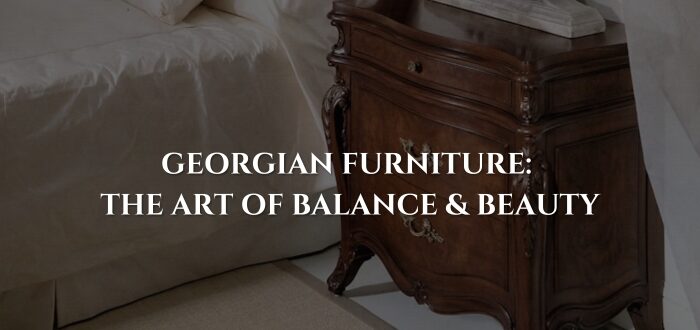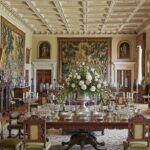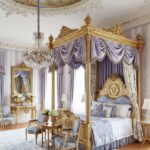Georgian Furniture: The Art of Balance & Beauty
In today’s age of modern and mass-produced interiors, where sleek modern aesthetics dominate, there is a resurgence of old-fashioned Georgian era furniture style. The Georgian style interiors are known for their sophistication and balance in furniture design. The Georgian era (1714–1830) remains a hallmark for elegant furniture and interiors. Named after the reigns of Kings George I, II, III, and IV, Georgian designs in furniture embody the ideals of symmetry, proportion, and understated elegance. This period represents not just beautiful pieces but also exceptional craftsmanship and elegance in British design. In this blog, we are going to explore Georgian era furniture, the history of Georgian furniture, its defining characteristics and provide you with home decor tips to style your space with these incredible pieces.

Also Read: Regal Furniture Style
The Georgian Period (1714–1837)
The era covering the reigns of King George I through George IV is collectively known as the Georgian period. This was a period characterized by social, political and cultural changes. There was a rise of a prosperous middle class with the global trade explosion. This led to the creation of furniture design to suit the new era. Advances in art and architecture also influenced the furniture design profoundly. In this era, Georgian furniture became a symbol of social standing, refined taste, and artistic excellence.
What Is Georgian Furniture?
Georgian furniture refers to pieces crafted or inspired by the stylistic ideals of the Georgian Period. Key traits include:
- Symmetry and proportion, echoing classical ideals.

- Focus on practicality paired with elegance.
- Quality construction in hardwoods like mahogany, walnut, cherry, satinwood, and rosewood.
- Softer ornamentation than earlier Baroque styles—expert veneers, delicate carving, and inlay work.
Characteristics of Georgian Furniture
Here are some defining features of Georgian era furniture:
- Symmetry and Balance
At the core of Georgian furniture design lies a devotion to symmetry and proportion. Influenced by Palladian architecture, designers sought harmony in every piece. Whether it was a stately dining table or a carved armchair, dimensions were carefully calculated to achieve a sense of visual balance and order.
- Exquisite Materials
Mahogany was the hallmark wood of the Georgian period, celebrated for its durability and deep, warm tone. Walnut and oak were also used, particularly in earlier pieces, while satinwood became popular in the late Georgian era. Fine veneers and inlays highlighted the natural beauty of these woods, showcasing both craftsmanship and material quality.
- Elegant Ornamentation
While Georgian design favoured restraint, ornamentation played a crucial role in elevating furniture. Common motifs included acanthus leaves, shells, scrolls, and rosettes, often carved with precision. These decorative flourishes never overwhelmed the form but added subtle richness and depth.
- Neoclassical Influence
By the late Georgian period, classical Greek and Roman art heavily influenced furniture design. Fluted columns, urn shapes, and acanthus leaf carvings echoed ancient architecture, giving pieces a timeless and cultured appearance. This neoclassical influence emphasized simplicity, straight lines, and elegant detailing.
- Functional Elegance
Georgian furniture combined beauty with practicality. Dining tables were often extendable, desks featured hidden compartments, and upholstery was designed to be removable. These innovations reflected a growing emphasis on comfort, adaptability, and everyday use—without sacrificing refinement.
- Refined Silhouette
The silhouette of Georgian furniture emphasized elegance and fluidity. Chairs often featured curved cabriole legs ending in ball‑and‑claw or pad feet, while tabletops displayed rounded corners or serpentine edges. The result was furniture that felt fluid and organic, yet balanced.
- Comfort with Style
Unlike purely ornamental pieces of earlier eras, Georgian furniture prioritized comfort. Wingback chairs, sofas with rolled arms, and well‑proportioned seating provided coziness without compromising elegance. Upholstery in rich fabrics or leather added both durability and visual luxury.
Also Read: Mid-Century Modern Furniture Style
Types of Georgian Furniture

- Chairs & Sofas
Wingback Chairs: Tall backs, side “wings” to protect from drafts—upholstered in leather or rich fabrics.
Sofas and Couches: Rolled arms, cabriolé or tapered legs, sumptuous upholstery—tailored and stately.
Side Chairs: Back‑splat designs, elegantly carved, often upholstered.
- Dining & Center Tables
Extendable Dining Tables: Designed for entertaining—drop‑leaf, gate leg, or extension mechanisms.
Console & Side Tables: Decorative legs, veneers, and occasionally inlaid motifs.
- Storage Furniture
Chests, Cabinets & Dressers: Featuring brass hardware, inlaid veneers, dove‑tailed joins.
Secretary Desks: Inclined fall‑fronts, pigeon‑holes, hidden compartments.
Sideboards: Large buffet pieces, often domed or architectural in form.
- Decorative & Accent Pieces
Pedestal urn stands, lamp tables, bookcases with glazed doors, and pier tables reflecting classical detailing.
Mirrors with gilt wood frames, often rectangular with cartouche or shell motifs.
Georgian Furniture In A Modern Home
Georgian furniture is more than history—it’s a versatile design that still feels fresh today. These timeless pieces can complement a range of aesthetics, whether as statement furniture in modern interiors or as part of a cohesive traditional scheme. For instance, a carved mahogany dining table pairs beautifully with minimalist chairs for an eclectic twist, while a Georgian sideboard instantly brings character to a sleek entryway.
Credit: HomeDecorInspiration
How To Style Georgian Furniture In Your Living Space?
- Use Neutral Colour Schemes
Keep walls and larger furnishings in soft, neutral tones—white, cream, or muted greys—so the rich wood tones and elegant forms of Georgian furniture take center stage.
- Balance Ornate with Minimalist Design
Georgian pieces often feature decorative carvings or strong silhouettes. Pair them with uncluttered décor—simple rugs, clean lines, and restrained accessories—to avoid overwhelming the room.
- Mix Old with New
- Blending styles creates energy and sophistication:
- Place a Georgian sideboard beneath a bold modern artwork.
- Pair a wingback chair with a glass or metal coffee table.
- Use an antique desk as the focal point in a contemporary office.
- Focus on Scale & Proportion
Georgian furniture respects human scale—chairs fit the body; tables sit at practical heights. When mixing into modern spaces, choose pieces that don’t dominate the room, and use pairs or symmetry to maintain balance.

- Highlight with Modern Lighting
Install subtle spotlights or statement lamps to draw attention to the craftsmanship of a Georgian table, chest, or chair. Good lighting emphasizes the wood grain, carvings, and refined silhouettes.
- Choose Harmonious Finishes
Dark woods like mahogany and walnut blend beautifully with neutral or earthy palettes. For a lighter look, opt for satinwood or painted late‑Georgian pieces, which bring brightness without losing period charm.
Final Thoughts
The aesthetic principles of Georgian furniture reflect a seamless blend of classical inspiration, meticulous craftsmanship, and functional design. With its dedication to symmetry, proportion, and refined ornamentation, the Georgian period set a design standard that still resonates with furniture makers and interior designers today. From early Baroque influences to the elegant neoclassicism of the late Georgian era, this trajectory tells a story of evolving taste and timeless appeal.
In contemporary homes, Georgian furniture offers more than beauty—it brings history, balance, and sophistication. Whether you acquire an antique chest, invest in a faithful reproduction, or style a Georgian sideboard against a modern backdrop, these pieces offer a rare quality: heritage that adapts seamlessly to modern living.






